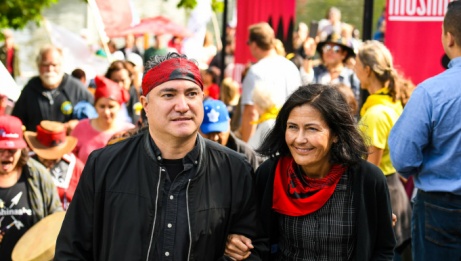In 1969, The Ecstasy of Rita Joe by George Ryga was the first theatre production presented at the newly opened National Arts Centre. This contemporary tragedy powerfully condemns the systemic brutality that confines Indigenous people to lives of social and spiritual poverty, stripping away pride, traditions, and language. The play made a lasting impact on Canadian theatre and society, raising awareness of the challenges faced by Indigenous communities and inspiring calls for greater understanding and reconciliation.
NAC English Theatre’s former Artistic Director, Peter Hinton, reprogrammed this landmark play in 2009 for the NAC’s 40th anniversary, collaborating with Indigenous director Yvette Nolan and casting Indigenous actors in all Indigenous roles. As part of his commitment to program at least one Indigenous show a season, Hinton later staged a groundbreaking all-Indigenous production of Shakespeare’s King Lear in 2012, featuring a cast that included August Schellenberg, Tantoo Cardinal, Monique Mojica, Lorne Cardinal, Craig Lauzon, and Kevin Loring.
Building on this foundation, English Theatre began exploring Indigenous theatre in 2014 with key gatherings of Indigenous artists, starting with The Summit at the Banff Centre—a three-day discussion on the breadth and scope of Indigenous dramaturgy. This was followed by The Study and The Repast on Manitoulin Island, where artists discussed steps to bring Indigenous stories closer to the heart of national expression amid rising awareness and reconciliation efforts in Canada. In 2016, the NAC formally announced the creation of an Indigenous Theatre department.
"I really see it as a place where the next great works could be developed,” said Michael Greyeyes, a Plains Cree actor and director, reflecting on this pivotal step in reshaping the Indigenous performing arts landscape in Canada.
In 2017, Nlaka’pamux playwright, performer, and director Kevin Loring was appointed the first Artistic Director of the new Indigenous Theatre department.
“I wish this day had come much sooner. In fact, I wish when we'd opened our doors in 1969, an Indigenous theatre department had been part of the fabric of this institution. But it's not too late, and today we are making one of the most significant steps in our 48-year history,” remarked Peter Herrndorf, then CEO of the National Arts Centre.
Kevin Loring added, “Our stories from coast to coast to coast are the original songs of this land. Now, through the Indigenous Theatre department, our stories will have a permanent home, a place to grow and thrive.”
In early 2018, Mairi Brascoupé, Lindsay Lachance, and Lori Marchand joined to form a small, dedicated team that would ultimately grow to program and launch the inaugural season in 2019.
The Mission: To develop, nurture, and showcase Indigenous stories at community, national, and international levels, honoring our storytellers and aiding in the retention, resurgence, and resilience of the diverse Indigenous cultures of this land.
The Vision: Our Stories are Medicine. Storytelling is transformative, embodying law, language, creation, protocol, histories, and the preservation of futures. It highlights cultural realities and lived experiences, re-writes histories, and celebrates communities.
The inaugural season began with Mòshkamo, a multi-day, NAC-wide festival celebrating Indigenous arts and culture, opening with a canoe procession along the Rideau Canal led by Algonquin community members. Indigenous Theatre’s first season highlighted a range of Indigenous voices, including Marie Clements’ The Unnatural and Accidental Women, which powerfully addressed the crisis of missing and murdered Indigenous women; Natalie Sappier's Finding Wolastoq Voice, the story of a young Wolastoqiyik woman awakened by ancestral voices; and Loring's Where the Blood Mixes/Là où le sang se mêle, confronting the harmful, lasting impact of residential schools.
Following seasons brought performances including Okinum by Emilie Monnet, Trace from Sandra Laronde's Red Sky, The Mush Hole by Santee Smith, and Tomson Highway: Kisaageetan, celebrating Highway's 70th birthday. In 2022, The Breathing Hole, presented in Nattilingmiutut and English, reflected cultural resilience through extensive consultation and collaboration, while Little Red Warrior and His Lawyer toured widely, evolving with each staging. Sold-out shows, school matinees, and extensive outreach marked Indigenous Theatre's programming.
Indigenous Theatre further amplifies Indigenous artistry through integral engagement and educational activities created and curated by Mairi Brascoupé and Kerry Corbiere, with community-centered events like beading workshops, powwow life drawing, and the popular Indigenous Women's Art Market leading the way. Online, #ReconcileThis, with support from Meta, invites Indigenous creators to share digital works on social media, sparking meaningful dialogue surrounding reconciliation, and digital projects, like Indigenous Cities and Dancing the Landᅳalongside streamed talks, book clubs, and classroom resourcesᅳcontinue to be highly valued learning tools.
Transformations in the building include NAC-commissioned works Dawn by Rebecca Belmore, and Heartbeat of Mother Earth by Emily Brascoupé-Hoefler, two permanent installations welcoming all who enter. Soon to be unveiled, a traditional birch bark canoe built during the Mòshkamo festival by Algonquin Elder, Pinock Smith. Biennial Indigenous art markets, All My Relations ticket invitations, and multilingual study guides have also broadened access and celebrated Indigenous audiences, reflecting the ongoing work of the NAC to build and maintain respectful, foundational relations with the host Algonquin Nation and relations with Indigenous nations and communities across the land.
Looking to the future, Loring sees "more presentations on all four stages, a larger footprint across the country from coast to coast to coast, supporting artists from diverse regions and Indigenous nations, with more Indigenous languages on our stages and bigger, better things to come."







